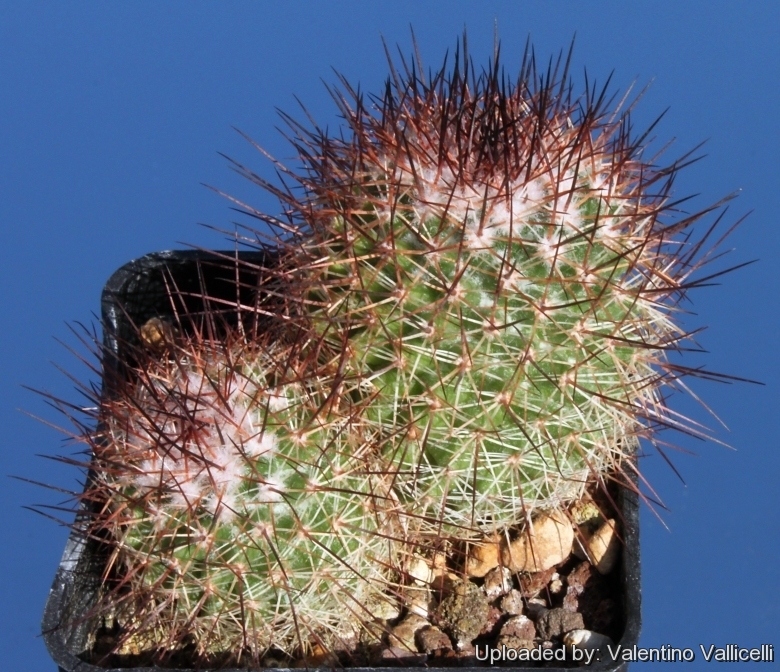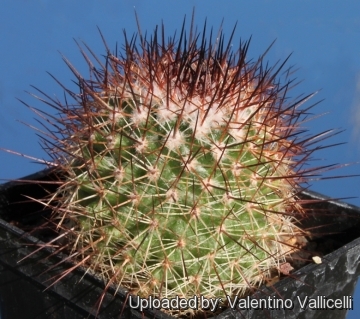




Your support is critical to our success.

Origin and Habitat: Mexico.
Synonyms:
- Mammillaria cylindrica (DC.) Don
- Cactus cylindraceus (DC.) Kuntze
- Mammillaria cylindracea DC.
Mammillaria cylindrica (DC.) Don
Gen. Hist. 157, 1834
Synonymy: 5
- Mammillaria cylindrica (DC.) Don
- Cactus cylindraceus (DC.) Kuntze
- Mammillaria cylindracea DC.
- Mammillaria cylindrica f. cristata hort.
- Mammillaria cylindrica flavispina Labour.
Description: The name “Mammillaria cylindricaSN|9140]]SN|13782]]” persists in cultivation when clearly the identity of the plant described is extremely vague and unreliable. Possibly it is a form of Mammillaria spinosissina with less but stronger spines reddish-brown central spines.
For example
Robert Craig's Mammillaria Handbook (1945) page 328 says:
Stem: Simple, cylindric, 125 mm high, 25 mm wide.
Tubercles: Deep green, ovate.
Areoles: Nearly naked.
Axils: Little setose.
Central Spines: 2, 6-8 mm long, rigid, divergent.
Radial Spines: 25-30, 2-4 mm long, white.
Distribution: Mexico. Type locality: None.
Remarks: This species has been referred by various authors to both Mammillaria coronario and
Mammillaria eriacanthaSN|13782]]SN|9140]] but it differs from both. Cactus cylindricusSN|4085]]SN|4085]] Ortega (Nov. Rar. Plant., 128, 1797) is not referable here as the radial spines count is less and it has milky sap.
Britton & Rose in The Cactaceae IV:172, 1922 say:
Mammillaria cylindricaSN|9140]]SN|13782]] Hitchen that appeared first, published by Forbes (Journ. Hort. Tour Germ.
147, 1837) but was so briefly described that it can not be identified. Hunt, in Bradleya, A new review Mammillaria rnames 1:128, 1983 Refers this plant of Mammillaria coronario that the name persists for a member of the Mammillaria spinosissima group, but that the plant in question was probably not a Mammillaria at all, being described as 150 cm tall. That leaves the reference to Mammillaria eriacanthaSN|13782]]SN|9140]] as the only name in popular use today.
Flowers colour is magenta..
Subspecies, varieties, forms and cultivars of plants belonging to the Mammillaria spinosissima group
 Mammillaria crassior Repp.: (subsp. tepoxtlana) Has very fine white yellow spines
Mammillaria crassior Repp.: (subsp. tepoxtlana) Has very fine white yellow spines  Mammillaria cylindrica (DC.) Don: The identity of this plant is extremely vague and unreliable. Possibly a form of Mammillaria spinosissina with few but strong brown spines?
Mammillaria cylindrica (DC.) Don: The identity of this plant is extremely vague and unreliable. Possibly a form of Mammillaria spinosissina with few but strong brown spines? Mammillaria cylindrica f. cristata hort.: Nice crestested form with white radials and dark brownish-red central spines.
Mammillaria cylindrica f. cristata hort.: Nice crestested form with white radials and dark brownish-red central spines. Mammillaria pilcayensis var. chrysodactyla Appenz.: Differs from M. spinosissima in its smaller more compact tubercles and finer spines. It grows quite tall in age and may need something to lean on. Distribution: Guerrero.
Mammillaria pilcayensis var. chrysodactyla Appenz.: Differs from M. spinosissima in its smaller more compact tubercles and finer spines. It grows quite tall in age and may need something to lean on. Distribution: Guerrero. Mammillaria spinosissima Lem.: (subsp. spinosissima) has cylindrical stems that rarely grows higher than 30 cm, dirty white spines and lacks bristles in the axils. It is very variable due to its wide area of origin. Distribution: Morelos, Guerrero, and Mexico.
Mammillaria spinosissima Lem.: (subsp. spinosissima) has cylindrical stems that rarely grows higher than 30 cm, dirty white spines and lacks bristles in the axils. It is very variable due to its wide area of origin. Distribution: Morelos, Guerrero, and Mexico.- Mammillaria spinosissima var. auricoma (A.Dietr.) Gürke: (subsp. tepoxtlana) Spines creamy white with pale orangiish to pinkish tips. Same as Mammillaria spinosissima ssp tepoxtlana??
 Mammillaria spinosissima var. auricoma f. cristata hort.: (subsp. tepoxtlana) Nice crested form with creamy spines that are pale orange-pink when young.
Mammillaria spinosissima var. auricoma f. cristata hort.: (subsp. tepoxtlana) Nice crested form with creamy spines that are pale orange-pink when young. Mammillaria spinosissima subs. pilcayensis (Bravo) D.R.Hunt: It has whiter spines, and the stems can grow up to 50 cm long/high. It might have some latex and bristles in the axils. The flowers are purple-pink. Distribution: Guerrero.
Mammillaria spinosissima subs. pilcayensis (Bravo) D.R.Hunt: It has whiter spines, and the stems can grow up to 50 cm long/high. It might have some latex and bristles in the axils. The flowers are purple-pink. Distribution: Guerrero. Mammillaria spinosissima f. rubrispina cristata hort.: Crested form. Forms tangled brain-like cushions up to 30 (or more) cm in diameter densely spined with bright coppery red spines.
Mammillaria spinosissima f. rubrispina cristata hort.: Crested form. Forms tangled brain-like cushions up to 30 (or more) cm in diameter densely spined with bright coppery red spines. Mammillaria spinosissima f. rubrispina hort.: The “rubrispina”” selection (a.k.a "Red-headed Irishman") forms nice clumps of columns, densely spined with bright coppery red spines.
Mammillaria spinosissima f. rubrispina hort.: The “rubrispina”” selection (a.k.a "Red-headed Irishman") forms nice clumps of columns, densely spined with bright coppery red spines.- Mammillaria spinosissima var. sanguinea (F.Haage) F.Haage in L.H.Bailey ex Brandegee: has a dark green cylindrical stem and long white spines, the central spines having red tips.
- Mammillaria spinosissima subs. tepoxtlana D.R.Hunt: It has yellow spines.
 Mammillaria spinosissima cv. Un Pico: This is a stable genetic mutation in which each areole only produces one spine, but some perfectly spineless areoles are also present.
Mammillaria spinosissima cv. Un Pico: This is a stable genetic mutation in which each areole only produces one spine, but some perfectly spineless areoles are also present. Mammillaria spinosissima cv. Un Pico cristata: Crested form. Forms tangled brain-like cushions up to 30 (or more) cm in diameter, each areole only produces one spine.
Mammillaria spinosissima cv. Un Pico cristata: Crested form. Forms tangled brain-like cushions up to 30 (or more) cm in diameter, each areole only produces one spine. Mammillaria spinosissima cv. Un Pico Monstruosa: Almost spineless. The monstrous form differs from the standard cv. Un Pico in having mostly spineless areoles with only few occasional spines scattered irregularly on the stem.
Mammillaria spinosissima cv. Un Pico Monstruosa: Almost spineless. The monstrous form differs from the standard cv. Un Pico in having mostly spineless areoles with only few occasional spines scattered irregularly on the stem.

Mammillaria cylindrica Photo by: Valentino Vallicelli
The gallery now contains thousands of pictures, however it is possible to do even more. We are, of course, seeking photos of species not yet shown in the gallery but not only that, we are also looking for better pictures than those already present. Read More...
Cultivation and Propagation: Mammillaria spinosissimaSN|13783]]SN|13783]] is an easy to grow species, just as a classic cactus, don't requires any special treatment, but need as much light as possible without burning the plant to encourage the heaviest spine formation. It is a great starter plant for the cactus grower, that readily builds up into a cluster of stems highlighted by reddish spines, further decorated by rings of purple-pink blooms.
Growth rate: It is a rapidly growing species. It offset from the base and can fill a 25 cm pot in just a few years given the best conditions.
Soils: It likes very porous standard cactus mix soil with little organic matter (peat, humus).
Repotting: Repotting every 2-3 years. As it is prone to rot under-pot in a smaller container filled with very porous compost. Use pot with good drainage.
Watering: Water regularly in summer, but do not overwater (very wet-sensitively, especially in light of its succulent root system). Its roots are easily lost in pots that stay damp for any length of time. Keep dry with ample airflow in winter. In the rest period no high atmospheric humidity!! Care must be taken with watering as they tends to become swollen and untidy in growth habit if given too much water and shade.
Fertilization: During the growing season enrich the soil using a fertilizer rich in potassium and phosphorous, but poor in nitrogen, because this chemical element doesn’t help the development of succulent plants, making them too soft and full of water.
Hardiness: It is quite frost resistant if kept dry, hardy as low as -5° C (some reports give it hardy to -12°C). However some warmth throughout the year will increase the grower's success (minimum 5° to 8°C during rest season).
Exposition: Outside bright sun, filtered sunlight or afternoon shade, inside it needs bright light, and some direct sun. Subject to sunburn if exposed to direct sun for too long. Tends to bronze in strong light, which encourages flowering and heavy wool and spine production.
Uses: It is an excellent plant for container growing. It always looks good and stays small. It look fine in a cold greenhouse and frame.
Traditional uses: The white, hooked spines of this spherical cactus were used as fish hooks in its native Mexico.
Pests & diseases: It may be attractive to a variety of insects, but plants in good condition should be nearly pest-free, particularly if they are grown in a mineral potting-mix, with good exposure and ventilation. Nonetheless, there are several pests to watch for:
- Red spiders: Sensitive to red spider mite. Overhead watering is helpful in controlling mites.
- Mealy bugs: Occasionally mealy bugs they develop aerial into the new growth among the wool with disfiguring results, but the worst types develop underground on the roots and are invisible except by their effects.
- Scales: Scales are rarely a problem.
- Rot: Rot it is only a minor problem with cacti if the plants are watered and “aired” correctly. If they are not, fungicides won't help all that much.
Propagation: Direct sow after last frost or (usually) or division . Seeds germinate in 7-14 days at 21-27° C in spring, remove the glass cover gradually as the plants develops and keep ventilated, no full sun for young plants! The seedlings should not be disturbed until they are well rooted, after which they can be planted separately in small pots. Cuttings: wait until the offsets that appear at the base of old clustered specimens are 1/3 the size of the parent and then detach and plant. Cuttings will take root in a minimum temperature of 20° C (but better in hot weather). Cuttings of healthy shoots can be taken in the spring and summer. Cut the stem with a sharp, sterile knife, leave the cutting in a warm, dry place for a week or weeks (depending on how thick the cutting is) until a callus forms over the wound. Once the callus forms, the cutting may be inserted in a container filled with firmed cactus potting mix topped with a surface layer of coarse grit. They should be placed in the coarse grit only; this prevents the cut end from becoming too wet and allows the roots to penetrate the rich compost underneath. The cuttings should root in 2 to 6 weeks.
| Your Actions | |
|---|---|
| Back to Mammillaria index | |
| Back to Cactaceae index | |
 |
Back to Cacti Encyclopedia index |
Privacy stantement - Terms and conditions - How to cite - About us - Feedback - Donate




